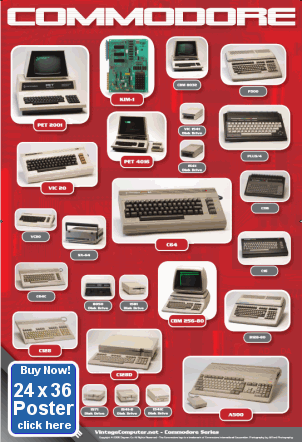 VC Blog | Contact
VC Blog | ContactThe Electronic Brain
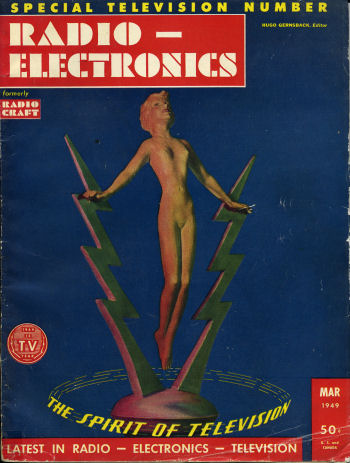
Radio Electronics March 1949
In the March 1949 issue of Radio Electronics there is a watershed article titled The Electronic Brain by W.R. Ashby, M.A., M.D.
The author describes recent (for 1949) advances in electronics and how they can be applied to the development of an artificial intelligence. He correctly predicts the potential of the vaccum tube as it relates to action-result feedback.
"..But nowadays the word "machine" has a much richer meaning, the position having been transformed by the invention of the electron tube. This device has two main properties: it allows power to be injected freely into a machine, causing high activity, and it provides a means by which one part of a machine can affect the behavior of another part with little back-action. At last those who would build a brain have something comparable in the functioning powers with the nerve cell."
The Homeostat
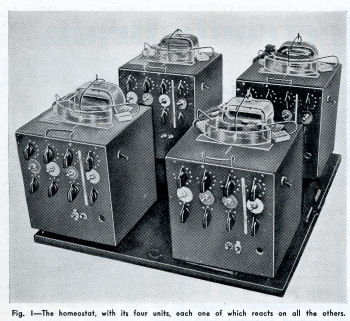
Click for larger image
Ashby illustrates his point by describing a facinating device called the Homeostat, which demonstrates negative feedback learning. He also discusses how this capability represents an advance in how electronic computers can "learn". He theorizes about how the Homeostat would approach the game of chess. "..the homeostat ... needs no detailed instructions, only some method by which it is informed of the occurence of illegal moves and mates. How the machine is to avoid these undesireable informations (feedbacks) is left entirely to the machine to puzzle out for itself. (The adaptations already shown by the homeostat encourage the confidence that whith only minor developments the machine will succeed)...
The homeostat would start off like any other player - simply by making more or less random movements. But the feedback would soon stop it making illegal movements, and it would tend steadily to avoid the moves that lead to a rapid loss of the game. .."
Other computers of the era, such as the Eniac, were limited to a set of detailed yet fixed instructions and no feedback mechanism. The Eniac had no means to learn or improve when performing such tasks as playing chess.
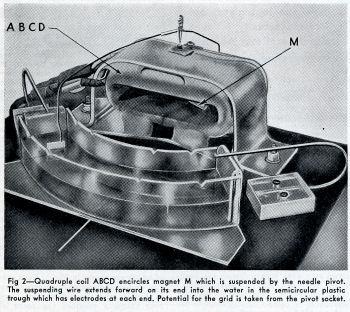
Quadruple Coil
Download Entire Article
University of Delaware Opens Computer Museum
There's a new computer museum at the University of Delaware and I am working as a sort of technical advisor to help assemble exhibits. Those of you at the Vintage Computer Festival will recognize it. The "TRS 80 Model 1 30th Anniversary" exhibit from the festival has found a home. Pictured are computers donated to the University, plus items from my collection. This fall I will be teaching a class titled "Preservation of Historical Microcomputers" as an adjunct professor. For more pics and information click here.
Click to view larger image.
Who was the original Braniac?
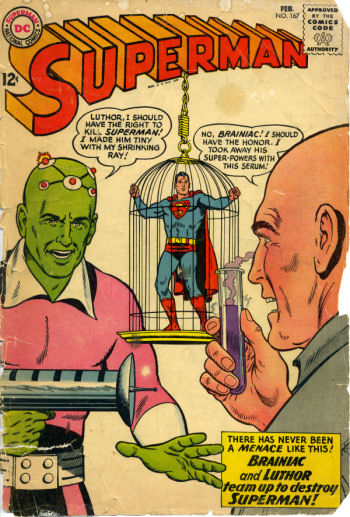
Berkeley's Brainic vs. The Brainiac!
From the Metropolis Mailbag:
SPECIAL ANNOUNCEMENT!
"...Thousands of DC readers have avidly followed the spectacular duels between SUPERMAN and his greatest foe, the nefarious scientist, BRAINIAC..."
And now let us go behind the scenes and unveil a remarkable coincidence. The fictional character, "Brainiac," was created for us by Otto Binder, a famous science fiction writer who is currently the editor of "Space World," a magazine for rocket experts. ..
Shortly after the first "Brainiac" story appeared in ACTION COMICS, in 1956, we learned that a REAL "Brainiac" existed ... in the form of an ingenious "Brainiac Computer Kit" invented in 1955 by Edmumd C. Berkeley. Mr. Berkeley is a distinguished scientist and a world authority on automation, computers and robots.
In deference to his "Brainiac," which pre-dates ours, with this issue of SUPERMAN we are changing the characterization of our "Brainiac" so that the master-villain will henceforth possess a "computer personality." ...
Readers will be interested to learn that they can build their own "Brainiac" by purchasing one of Mr. Berkeley's computer kits and assembling the parts. Thousands of youngsters, as well as adults, have bought these kits and, by following the simple directions, have been able to construct home-made computers which can solve interesting problems of all kinds. "Brainiac kits cost less than $20.00 and make an ideal educational hobby. For more information, write for free literature to: Berkeley Enterprises, Inc., 815 Washington Street, Newtonville 60, Mass. .."
Inside the Amazing ASR 33
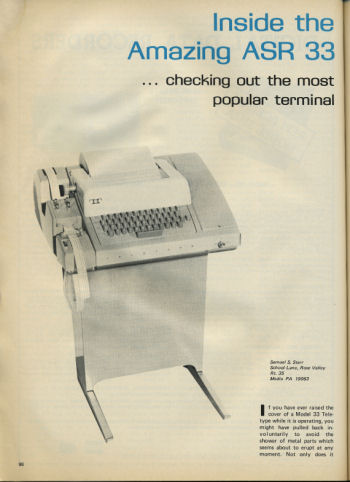
Click to download the entire Samuel S. Starr article from Kilobaud July 1977
The Model ASR 33 Teletype was the defacto I/O device for early microcomputer pioneers. These machines were used as both display terminals AND storage. Today, it is not easy to come by a working unit and you have to usually scrounge around for parts. The other day I picked up another ASR 33, below. This one looks worse than it really is! A few turns of the screw and ... actually the power supply is fine, and that's really what I bought it for. Check the blog area for updates on this project.
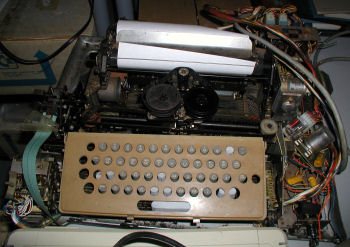
Click for larger image
Commodore Disk Archive Project
I have begun the ambitious project of archiving all the Commodore disks in my inventory. Although I have the process down to less than 30 seconds per disk, it will still take many months to complete the project.Learn more about how to make backups of Commodore disks.
Cybercrud
What the heck, vintagecomputer.net is now also cybercrud.com, named after the Theodor Nelson Computer Lib article. What is Cybercrud?Past Issues:
On the Work Bench - Aug 2007
These are some of the computers and things that I am currently working on, or have recently picked up. Check my Vintage Computer Blog for updates, or post your questions.XOR S-100-4 Computer
I recently purchased this fine example of a later S-100 system from around 1982. Click images for larger versions.
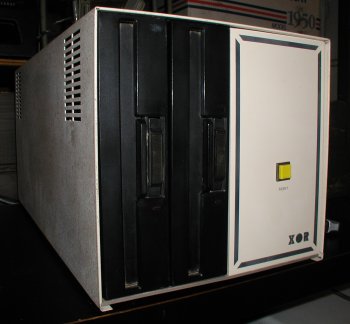
Front View of XOR system
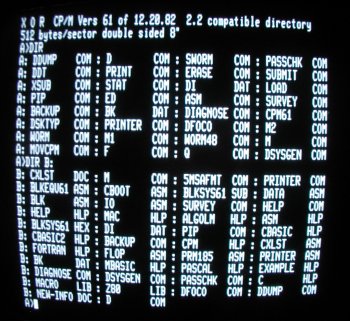
XOR CP/M 2.2 drive A and B directory display
More pictures and XOR info here
Epson Geneva PX-8
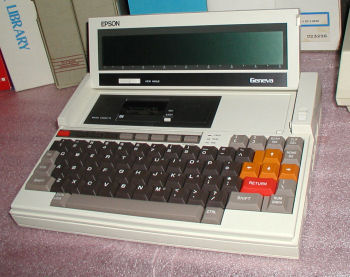
Click Image for larger version
The Epson Geneva PX-8 was an early LCD laptop from Epson. It ran CP/M and used a Z-80 processor. The standard storage was a mini cassette, but an external 3.5" disk drive was available. I have done some preliminary testing of this system, the LCD is a little weak. Fortunately I have a replacement display. I have the complete documentation and extra parts as well as the complete system. In addition to the PX-8 system I have a CX-80 Acoustic Coupler modem, a PF-10 external 3.5" disk drive, and Dbase II, The "Travelers Pack", and the Epson Software Libarary software.
Sinclair 1000 and ZX81
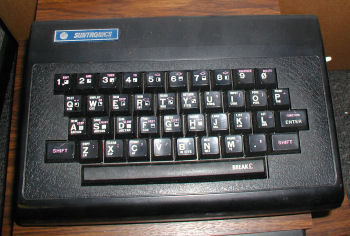
A Sinclair 1000 sporting the Suntronics keyboard upgrade
Here are some photos of various Sinclair systems..
Timex Sinclair 1000 / ZX81 items. A Seikosha SP 1000 AS printer.
I have 6 boxes of books and hardware, plus about 150 tape programs to catalog.
Assembly programming for the Sinclair I can believe..Forth? I had no idea how seriously people took these machines.
I will probably put some of this up for sale, if anyone is interested, let me know.
My favorite item is the Suntronics Sinclair keyboard kit pictured above. Makes the system so much more usable with a good keyboard.
A 1/2 Bushel of Apple II's
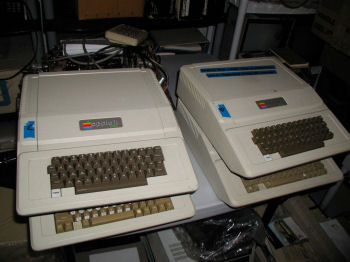
Click for larger image.
I made a local pick up of 3 Apple IIe's and 3 Apple II Plus computers in various states of operational status, all restorable. They were all clean and the lot came with a lot of useful software, cards, joy sticks, printers, spare parts, monitors, including a Corvus external hard drive. A van full of gear.
Franklin Ace 1200
Click for larger image.
I received a replacement keyboard from Erik Klein for my Franklin Ace 1200. The original has a bad space bar.
While in the process of taking apart the system to install the keyboard, I snapped a few pictures.
Pictures
I need the system disks, to test the drives.
Classic Computing Items for Sale:
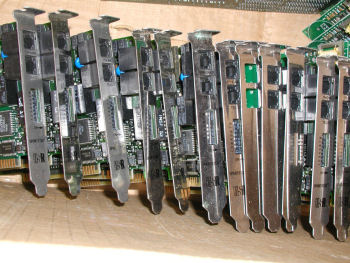
| CBM Commodore B Series Software (B-128 / CBM 700) | ||
| Superscript II Word Processor | $29.99 | |
| Superbase Database Manager | $29.99 | |
| Commodore Advanced Business Systems (CABS) Acccounting Suite: Accounts Payable, Order Entry, Accounts Receivable, General Ledger (4 binders) | $29.99 | |
| More CBM Commodore Items | ||
| Commodore B-128/700 Programmer's Reference Guide - Protecto - Everything you need to know about the B line! | SOLD OUT | |
| B Series Commodore Users Guide - View Image | $39.99 | |
| Commodore Users Guide Series 8000 | $39.99 | |
| Commodore BASIC Users Refence Manual Version 4.0 | SOLD OUT | |
| Commodore CBM Expansion Memory Board 64K Expansion Kit for PET 8032 (NOS) | SOLD OUT | |
| Commodore PET Keyboard (NOS) for 2001 -N, 3000, 4000 Series | SOLD OUT | |
| Other Commodore CBM Power supplies, software, parts, etc. | Contact Me | |
| Tandy Items | ||
| Aeoromp Double Density Controller for TRS 80 Model 1 Expansion Unit (NOS)- details | SOLD OUT | |
| Model III / Model 4 (non-gate array only) RS-232 KITS details | SOLD OUT | |
| Model III / Model 4 (non-gate array only) RS-232 boards only | SOLD OUT | |
| Model III Aerocomp Diskdrive controller | $39.99 (free US Ship) | |
| Looking for Something Else? | ||
| Please check here first with special requests for Commodore, IBM, Tandy, Atari, TI, Apple computers, parts, components, and software. I have systems plus zounds of miscellaneous items for sale or trade. | ||
For more information about the C Prompt found at the top of each page, click here.
All photography on this web site is © VintageComputer.net/Bill Degnan and cannot be reproduced without permission.
This web site has two purposes.
For years I have been making research notes while in the process of restoring classic computer systems, and I also like to record tidbits of information that I think might be useful in the future. This web site is a way to share this information for research purposes. I will also post restoration project reports, project summaries, users guides, tutorials, and items wanted. I invite anyone who wishes to contribute their comments to the VC Blog to do so. My goal is to publish new content in the field of classic computing.
The second purpose of this web site is to sell off my duplicate items. Unless otherwise stated, all items for sale are in working order. If you wish to post items for sale on the VC Blog, please indicate clearly the operational status of the item(s).
All photography on this web site is © VintageComputer.net/Bill Degnan and cannot be reproduced without permission.
This web site has two purposes.
For years I have been making research notes while in the process of restoring classic computer systems, and I also like to record tidbits of information that I think might be useful in the future. This web site is a way to share this information for research purposes. I will also post restoration project reports, project summaries, users guides, tutorials, and items wanted. I invite anyone who wishes to contribute their comments to the VC Blog to do so. My goal is to publish new content in the field of classic computing.
The second purpose of this web site is to sell off my duplicate items. Unless otherwise stated, all items for sale are in working order. If you wish to post items for sale on the VC Blog, please indicate clearly the operational status of the item(s).
